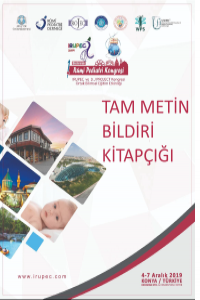Abstract
Crohn's disease (CH) is a chronic inflammatory condition that can occur anywhere in the gastrointestinal tract. Although CH can contain any part of the gastrointestinal tract, 20% of patients have isolated colonic disease, 30% of small intestine, and 50% of ileum with colon involvement. It is known that 25% to 30% of all CH cases occur in children under 19 years of age. CH occurs mainly with gastrointestinal symptoms such as abdominal pain, diarrhea and blood in the feces, but since it is a systemic immune disease, it affects other systems as well as being involved in the digestive system and indicates extraintestinal symptoms (arthritis, rash, developmental delay….). Endoscopic findings include mucosal edema, erythema, granuloma, cobblestone, ulcer and stenosis. It has shown that in cases with inflammatory bowel disease, extraintestinal symptoms are often CH and the incidence is between 6% and 47%. Aggressive treatment is required in children with CH due to reasons for direct growth effect, especially height and weight gain. [1,2]
METHODOLOGY
A 13-year-old female patient was evaluated by the emergency department which she applied for acute appendicitis and consulted with the pediatric surgery department, and the patient is operated for appendectomy. The patient's surgical material shows a bleeding ulcer at the end of the 18 cm small intestine, and the mucosa is flattened. In the 13 cm large intestine segment, a 2.5 cm bleeding edematous polypoid appearance, ulcer and multiple lymph nodes and cecum necrosis are observed. Considering that there will be no primary repair; the patient underwent appendectomy, right hemicolectomy and excision of 15 cm of ileum. During the histopathological examination of the surgical material, ulcers in the small and large intestine, pseudopolip, aphthous erosion on the surface, ischemic active chronic inflammation, cryptitis, sparse crypt abscess, crypt distortion, submucosa giant cell-containing histiocyte community (foreign body granuloma?) was reported and was referred to pediatric gastroenterology department. One week before the operation, the patient had severe leg pain, which showed withdrawal to the groin in the right leg; moreover she had complaints of loss of appetite, bad breath, and was not accompanied by fever, abdominal pain, vomiting, bloody stools, and tenesmus. On the physical examination, she had a height of 152 cm (10-25 p), weight: 49 kg (25-50 p), pallor, abdominal scar, and clubbing. Laboratory indicators were as follows: Hemoglobin: 11.5 g / dL, White cell: 8400 / mm3, Platelet: 822,000 / μL, MCV: 82 fl, RDW: 18%, Ferritin: 36 ng / mL (normal range: 11-3060 ng / mL ), Iron: 51 μ / dL (normal range: 33-193 μ / dl) Vitamin B12: 189 pg / ml Sedimentation 1 h: 10 MM /, stool hHb: negative.
For possible granulomatous pathologies, PPD was negative, Quantiferon was negative, chest X-ray was normal, wide stool examination were normal, and celiac autoantibodies were found to be normal. Colonoscopy could not be performed because the operation time was not appropriate, but it was planned to be performed in the follow-up. For CH Anti-Saccharomyces Cerevisiae ’Antibody Ig CH and Ig G was positive and Perinuclear Anti-neutrophil Cytoplasmic Antibody was negative. The patient was accepted as CH and started treatment and was followed up. Weight gain was achieved with enteral support including steroids, immunomodulators and TGF-B, and clinical recovery was achieved.
CONCLUSION
The patient who had no complaints before atypical presentation was diagnosed as crohn's disease after further examination; this caused early treatment of the patient and leading to close follow-up for possible complications. CH follows a chronic, progressive course in which many patients require complicated surgical intervention. Nowadays, clinical remission based solely on symptom control is no longer acceptable and has been associated with surgical risk in mucosal healing, length of hospital stay, reduction of disease-related complications, and longer-term clinical remission.
Keywords
References
- References 1. Sawczenko A, Ballinger AB, Savage MO, Sanderson IR. Clinical features affecting final adult height in patients with pediatric-onset Crohn's disease. Pediatrics 2006;118:124-9. PUBMED | CROSSREF 9. 2. Kanof ME, Lake AM, Bayless TM. Decreased height velocity in children and adolescents before the diagnosis of Crohn's disease. Gastroenterology 1988;95:1523-7. PUBMED | CROSSREF 10. 3. Maaser, C., Sturm, A., Vavricka, S. R., Kucharzik, T., Fiorino, G., Annese, V., ... & Burisch, J. (2019). European Crohn's and Colitis Organisation [ECCO] and the European Society of Gastrointestinal and Abdominal Radiology [ESGAR]. ECCO-ESGAR Guideline for Diagnostic Assessment in IBD Part 1: Initial diagnosis, monitoring of known IBD, detection of complications. J Crohns Colitis, 13(2), 144-64. 4. Allez, M., Lemann, M., Bonnet, J., Cattan, P., Jian, R., & Modigliani, R. (2002). Long term outcome of patients with active Crohn’s disease exhibiting extensive and deep ulcerations at colonoscopy. The American journal of gastroenterology, 97(4), 947-953.
Abstract
References
- References 1. Sawczenko A, Ballinger AB, Savage MO, Sanderson IR. Clinical features affecting final adult height in patients with pediatric-onset Crohn's disease. Pediatrics 2006;118:124-9. PUBMED | CROSSREF 9. 2. Kanof ME, Lake AM, Bayless TM. Decreased height velocity in children and adolescents before the diagnosis of Crohn's disease. Gastroenterology 1988;95:1523-7. PUBMED | CROSSREF 10. 3. Maaser, C., Sturm, A., Vavricka, S. R., Kucharzik, T., Fiorino, G., Annese, V., ... & Burisch, J. (2019). European Crohn's and Colitis Organisation [ECCO] and the European Society of Gastrointestinal and Abdominal Radiology [ESGAR]. ECCO-ESGAR Guideline for Diagnostic Assessment in IBD Part 1: Initial diagnosis, monitoring of known IBD, detection of complications. J Crohns Colitis, 13(2), 144-64. 4. Allez, M., Lemann, M., Bonnet, J., Cattan, P., Jian, R., & Modigliani, R. (2002). Long term outcome of patients with active Crohn’s disease exhibiting extensive and deep ulcerations at colonoscopy. The American journal of gastroenterology, 97(4), 947-953.
Details
| Primary Language | English |
|---|---|
| Subjects | Health Care Administration |
| Journal Section | Congress Proceedings |
| Authors | |
| Publication Date | December 10, 2019 |
| Acceptance Date | January 16, 2020 |
| Published in Issue | Year 2019 Volume: 7 Issue: Ek - IRUPEC 2019 Kongresi Tam Metin Bildirileri |


